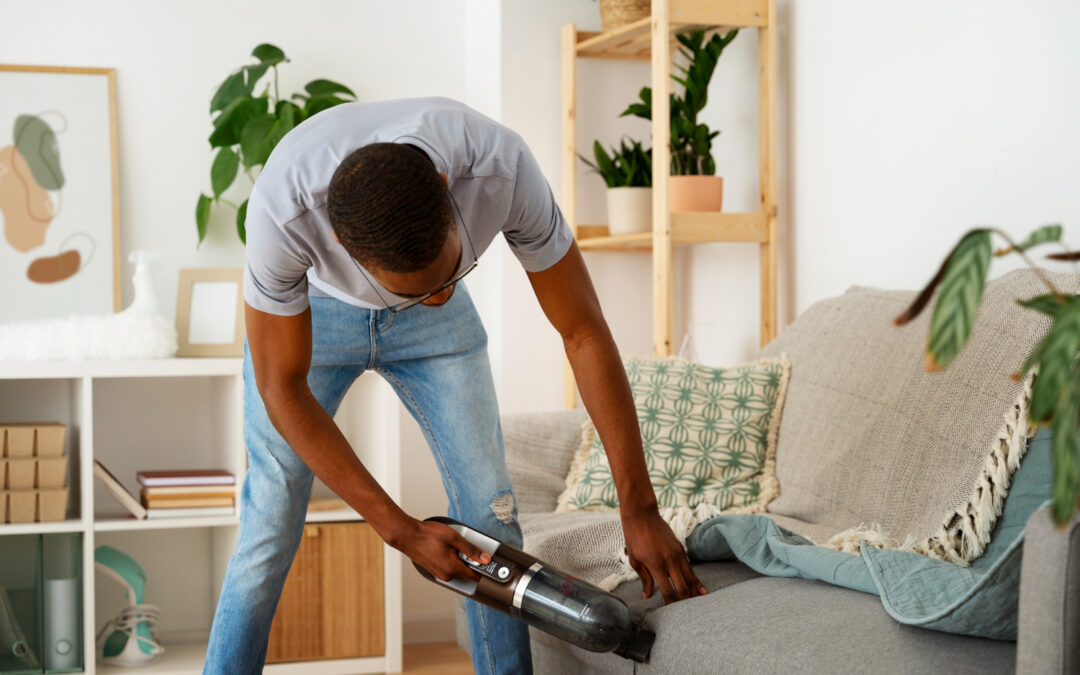Upholstery adds comfort and style to any room, but it also attracts stains from everyday spills, dirt, and mishaps. From spilt coffee to muddy paw prints, these stains can quickly diminish the appearance of your furniture and become more challenging to remove over time.
Understanding how to tackle tough stains effectively can save you both time and the potential expense of replacing furniture. Upholstery stains vary, and different stain types require different cleaning approaches to ensure they are removed without damaging the fabric.
Armed with the right information and tools, you can manage these stains quickly and maintain the beauty of your upholstery. Taking timely action also helps prolong your furniture’s lifespan while keeping your living space fresh and inviting.
Understanding Different Types of Upholstery Stains
Upholstery stains come in various forms, each requiring a unique cleaning approach. Food stains such as ketchup, chocolate, and grease are common on sofas and chairs. These require absorbent cleaning solutions to lift oils and pigments. Drink stains like red wine, coffee, and soda typically demand a blot-and-lift method to prevent liquids from setting into the fibres.
Ink stains present a unique challenge due to their permanent pigments and quick absorption into fabric. Marker and pen stains might require alcohol-based solutions to break down the ink. Understanding the composition of each stain helps determine the best cleaning strategy, as the wrong method could worsen the mark.
Immediate action is crucial when dealing with stains. The longer a stain sits, the harder it becomes to remove. Fast response in blotting and applying the right stain remover can prevent lasting damage. A timely approach not only preserves the upholstery but also minimizes the likelihood of needing a complete professional cleaning, helping maintain the furniture’s appearance and value.
Essential DIY Stain Removal Techniques
Effectively removing stains from upholstery involves a few crucial steps. Begin by blotting the spill with a clean, dry cloth to absorb as much liquid as possible. Avoid rubbing, which can push the stain deeper into the fabric. Next, apply a suitable cleaning agent using a damp cloth, gently working it into the stain. Let it sit briefly, then blot again to lift the stain.
Natural remedies like baking soda and white vinegar are popular for those preferring chemical-free options. Baking soda helps absorb odours and can be sprinkled onto wet stains before vacuuming. Vinegar, mixed with water and a bit of dish soap, can break down tough stains. In contrast, commercial cleaning products offer more targeted action, with some designed for specific stain types or fabric protection.
Mistakes to avoid include using hot water, which can set stains, and over-saturating the fabric, leading to water marks or mould. Always test a small, hidden area of your upholstery with a cleaner before full application to ensure no colour damage occurs. These DIY techniques, along with care and attention, can effectively tackle most stains while protecting your furniture.
Tools and Products for Effective Upholstery Cleaning
Having the right tools can make all the difference in tackling stubborn upholstery stains. A quality vacuum cleaner with an upholstery attachment is essential for regular maintenance, helping to remove loose dirt and debris before they settle into the fabric. Microfibre cloths are ideal for spot cleaning due to their absorbent and non-abrasive qualities. A soft-bristled brush can also be useful for working cleaning solutions into the fabric without causing damage.
Eco-friendly cleaning solutions are a smart choice for both safety and environmental considerations. Products free from harsh chemicals reduce the risk of damage to your upholstery and pose less risk to pets and children. Many natural cleaners are derived from biodegradable ingredients, making them a sustainable choice for regular use.
Selecting the right cleaning products involves understanding your upholstery’s fabric type. Check care tags and manufacturers’ guidelines for recommended cleaning agents. Avoid generic all-in-one solutions that might not suit every situation. Instead, choose products tailored for specific stains or fabric types to ensure effectiveness and preserve the upholstery’s appearance.
Preventing Stains and Maintaining Upholstery
Simple habits can keep your upholstery stain-free. Regularly rotating cushions can reduce uneven wear and prevent fibre compression. Promptly wiping up spills with a dry cloth can prevent stains from setting, while keeping food and drinks away from sofas and chairs minimizes accident chances.
Upholstery protection options include applying fabric protectors that add a barrier against liquids and dirt. These can help repel stains and are available in both spray-on and professional treatment forms. Consider reapplying these treatments annually or as the product guidelines recommend for best protection.
There are times when professional cleaning is necessary. If stains become too stubborn or if the upholstery emits lingering odours despite your best efforts, it’s wise to reach out for expert help. Professionals have access to advanced equipment and expertise to handle complex cleaning challenges without risking damage to your furniture.
Conclusion
Upholstery stains are a common part of everyday life but don’t need to be a permanent issue. You can keep your furniture looking fresh by understanding how to treat different stains, using DIY techniques, and employing the right tools and products. Regular care and maintenance go a long way in preserving the fabric and enhancing its longevity.
For those deeper cleaning needs or when stubborn stains just won’t budge, consider the specialized services at Zemtash Carpet Cleaning. Our team is ready to help, ensuring your upholstery remains in top condition for years to come. Contact us at 587-864-4560 to learn how our upholstery cleaning service can assist in keeping your living spaces clean and comfortable.




